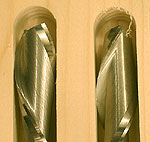This is a Veteran Owned site
While both of these Infinity bits are very effective, knowing when to use an up cut (left) or a down cut (right) can make a substantial difference in your project. Click image to enlarge |
Up Cut vs. Down Cut Router Bits
Choosing the right one
Text & Photos by Tom Hintz
Choosing between up and down cut router bits is one of many things in woodworking that can be frustrating until the reasoning behind the design difference is understood a little better. The number of email questions on this subject instigated this story.
The Difference
Though the flutes run in opposite directions, telling an up cut from a down cut bit can be difficult if you cannot imagine their rotation in the router. Though a router always turns in the same direction, from the operators perspective, that rotation appears to reverse depending on if the router is bit down in the common hand-held mode or bit up, as when mounted in a router table.
With the bit down, the rotation is clockwise. That means the side of the bit farthest from the operator is turning left to right, the near side right to left. This is very important for feed direction, as we always want the cutting edges turning against the feed direction, not with it.
 |
The down cut bit (left) leaves very clean edges while the up cut version (right) is far better at evacuating chips but that action can fray the edges of the cut to some degree. Click image to enlarge |
When the router is oriented with the bit up, as when mounted in a router table, the side of the bit closest to the operator is turning left to right and the back side right to left. Because the wood is fed against the rotation of the cutting edges, we almost always work against the front side of the bit.
If the wood is fed into a router bit on the wrong side, the feed direction matches the bits rotation, making a dangerous kick out all but certain. Feeding the wood with rather than against bit rotation allows the cutting edges to become highly efficient feed dogs that grab the wood, accelerate it and shoot it off the table at dangerous speeds.
Up Cut Bits
Up cut bits are very efficient at evacuating chips from the hole or slot it is cutting. This is especially important when the hole is ¼"-deep or more. Deep holes or grooves still have to be cut using multiple light cuts, but the upward direction of the flutes while rotating prevent the debris from building up in the hole and binding or even breaking the bit.
The problem with up cut bits is that the same action of the flutes that brings the chips up can also lift or fray the wood fibers around the edges of the cut. While this damage is usually minor, especially with good quality bits, it can be noticeable if those edges will be visible when the project is assembled.
Up cut bits are frequently used for cutting mortises because of their depth. Since the edges of a mortise are eventually hidden by the shoulders of the tenon that will be fit to it, this chipping or fraying will be hidden after assembly and have no impact on the finished project.
Down Cut Bits
 |
This closer look at the grooves cut by the down cut (left) and up cut (right) shows the marked difference in the edges they produce. Click image to enlarge |
The downward slicing action of a down cut bit leaves a very clean, crisp edge around the hole or groove it cuts. While chips still are evacuated from the hole, a down cut bit is far less efficient in this respect than is an up cut design.
This chip ejection deficiency of down cut bits is minimized by the relatively shallow cuts they most commonly are used to make. Down cut spiral bits are a good choice for cutting dados or shallow grooves, especially when the edges will be visible when the project is assembled.
Down cut bits require a slightly slower feed rate. This reduced pace allows the bit a little more time to throw chips out and for them to be re cut into smaller pieces that eventually are thrown from the hole or slot.
Making shallow cuts to achieve the full depth needed is always important, but especially so with a down cut bit. The combination of a deep cut and a build up of chips can cause the bit to over heat and even break.
For most woodworkers, the down cut type of spiral bit is most useful, particularly for those using a router to cut dados, rabbets and visible slots. Some woodworkers like cutting mortises with a router, table mounted or hand-held. For them, the up cut bit will be most efficient.
The ideal situation is to have both types of spiral bits in the drawer, in the size or sizes you most often use. The quest for more tools certainly does not end with spiral router bits.
Up and down cut spiral bits are available in sizes ranging from ¼" to ½." We used bits from Infinity Tools for this story, both ½"-diameter. The Infinity part numbers are, up cut bit – 85-913, the down cut bit – 85-914.
Visit the Infinity Tools web site – Click Here
Have a comment about this story? – Email Me!
Back to the Tips & Tricks List
All written, photographic and drawn materials are property of and copyright by NewWoodworker.com LLC 2000-2019. Materials may not be used in any way without the written permission of the owner.


